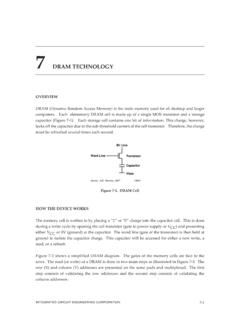Dram Design Overview
Found 9 free book(s)TN-ED-04: GDDR6 Design Guide - Micron Technology
www.micron.comsignal is such that it is always sourced from DRAM to controller, for both reads and writes. Due to this, extra care is recommended during PCB design and analysis ensuring the EDC net is evaluated for both near-end and far-end crosstalk. TN-ED-04: GDDR6 Design Guide GDDR6 Overview CCM005-524338224-10517 tn_ed_04_gddr6_design_guide.pdf - Rev. B ...
Understanding DRAM Operation - Computer Architecture …
compas.cs.stonybrook.eduUnderstanding DRAM Operation 12/96 Page 1 Overview Dynamic Random Access Memory (DRAM) devices are used in a wide range of electronics applications. Although they are produced in many sizes and sold in a variety of packages, their overall operation is essentially the same. DRAMs are designed for the sole purpose of storing data.
Chapter 1: HIR Overview and Executive Summary
eps.ieee.orginnovation in design and process technologies continue the drive to advanced nodes, Moore’s-Law economics and performance are evidently plateauing. Shown below are two graphs presented by John Hennessy at the ERI Conference in July 2018 [5]. The graph to the left shows forty years of DRAM capacity and the slowing down of
DRAM Design Overview - Stanford University
www.graphics.stanford.eduDRAM Design Overview Junji Ogawa ASSP/ASIC Standard Operating Frequency Customizability WRAM VRAM DRAM/Logi c SLDRAM CDRAM EDRAM EDO MDRAM Function rich DRAM 100MHz 200MHz 500MHz DDR 1GHz 2GHz High-speed DRAM Target SDRAM RAMBUS DRAM Operating Frequency v.s. Customizability Feb. 11th. 1998 DRAM Design Overview Junji Ogawa
DRAM Technology - Smithsonian Institution
smithsonianchips.si.eduOVERVIEW DRAM (Dynamic Random Access Memory) is the main memory used for all desktop and larger computers. Each elementary DRAM cell is made up of a single MOS transistor and a storage capacitor (Figure 7-1). ... Design improvements allow for the decrease in …
TN-41-13: DDR3 Point-to-Point Design ... - Micron Technology
www.micron.comright memory design methodology can be critical to a project’s success. While DDR3 SDRAM was targeted for use on modules, it can easily be adapted for point-to-point ap-plications. DDR3 is an evolutionary transition from DDR2. DDR3 point-to-point systems are simi-lar to DDR2 point-to-point systems; both require similar design principles. But ...
NAND vs. NOR Flash Memory Technology Overview
aturing.umcs.maine.eduApr 25, 2006 · DRAM in which the program code can be shadowed and run. In either case, the different types of memory are frequently stacked in Multi-Chip Packages (MCP) to create a single component. This overview will briefly discuss the history of …
SEMICONDUCTOR MEMORIES - University of California, …
bwrcs.eecs.berkeley.eduThe read-out of the 1T DRAM cell is destructive; read and refresh operations are necessary for correct operation. Unlike 3T cell, 1T cell requires presence of an extra capacitance that must be explicitly included in the design. When writing a “1” into a DRAM cell, a threshold voltage is lost.
Memory Basics - Michigan State University
www.egr.msu.edu– Dynamic: will lose data unless refreshed periodically (DRAM) ECE 331, Prof. A. Mason Memory Overview.2 SRAM/DRAM Basics •SRAM: Static Random Access Memory – Static: holds data as long as power is applied –Volatile: can not hold data if power is removed – 3 Operation States: hold, write, read – Basic 6T (6 transistor) SRAM Cell








